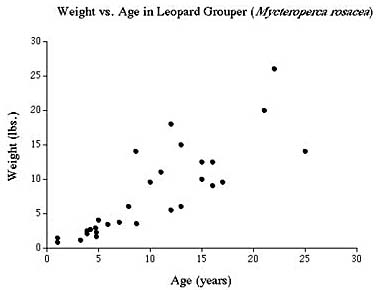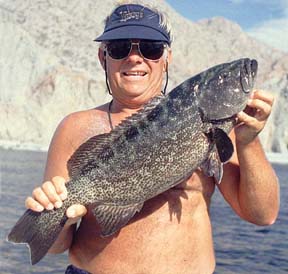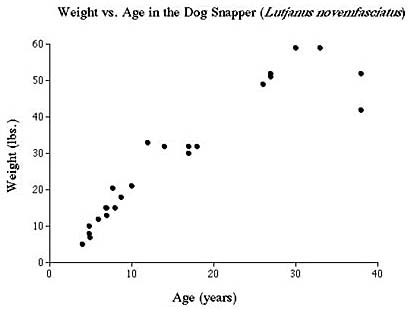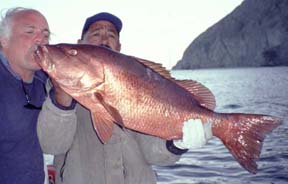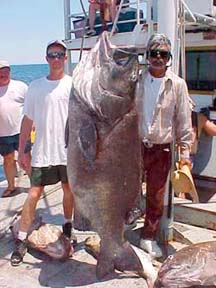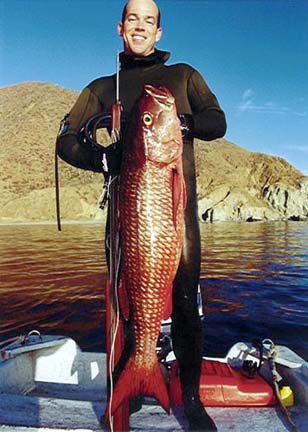
How Old Is That Fish? Myth vs. Hard Data
![]()
|
A seven-pound leopard grouper is about ten years old. |
AN AGE-SIZE DISTRIBUTION STUDY SHOWS THAT SOME SLOW-GROWING
FISH MAY NOT BE AS OLD AS MYTH AND LEGEND WOULD HAVE IT
Oct 4, 2000, by Gene Kira:
One of the reasons often cited for not catching larger groupers and other slow-growing resident reef species in Mexican fishing waters is that these fish can be very old, maybe centuries old... maybe even "as old as the churches," to quote the Mexican fisherman, Abundio Rodriguez, in my novel King Of The Moon.
Ray Cannon, the legendary Baja sportfishing writer, was pretty old himself (in his 70s and early 80s) when he helped popularize the myth of the century-old giant grouper in the pages of Western Outdoor News.
But, how much truth is there to this widely-held belief?
|
|
Not much, according to Dr. Mark A. Steele of UCLA and his collaborator, Sean Anderson, who have done some interesting and valuable research on three species of fish that are frequently caught in the Sea Of Cortez: leopard grouper (commonly called "cabrilla"), dog snapper, and gulf grouper.
What Dr. Steele has observed is that size, up to about 30 pounds in weight, is a fairly good indication of fish age. Above 30 pounds, there is quite a bit of variation, but in no case has he observed or even heard of these fish approaching 100 years of age. (Dang! That was a good story, too.)
Taking the smallest fish first, Dr. Steele's chart for the leopard grouper (shown below) shows that a "real nice one" weighing, say, 25 pounds is probably about 25 years old, which is also the age of the oldest fish observed. A "pretty nice" leopard grouper (certainly a "keeper") weighing 10 pounds is only about 15 years old.
For the larger and faster-growing dog snapper (shown on chart below), the ages per weight class are considerably less. A 25-pounder is only about 12 years old, and a 10-pounder is just a young whipper snapper at 5 years old. Note also that the oldest observed fish, weighing about 40 to 60 pounds, were all less than 40 years old.
As the fish get older, size becomes a less predictable indicator of age. Dr. Steele observes, "For example, in dog snapper (pargo prieto), the oldest fish that we had in our sample was almost 40 years old, but weighed only about 40 pounds, whereas we had a fish that was over 45 pounds but only about 25 years old. Below 25 years of age, size was a good predictor of age."
|
A seven-pound dog snapper is about ten years old. |
For the largest species observed, the gulf grouper (see chart below), the growth rate is even faster. A 25-pounder is only about 5 years old, and a 10-pounder might only be 2 years old. Note also that the largest two fish observed, weighing over 100 pounds, were only about 17 and 23 years old, respectively. Also, that the oldest fish observed was only about 25 years old, and it was not the largest.
Dr. Steele points out that although the gulf grouper is by far the largest fish of the three observed, it gets no older than the smallest, the leopard grouper. Both fish top out about 25 to 30 years. This is a far cry indeed from "as old as the churches."
|
A 100-pound+ gulf grouper, comparable in size to this black seabass, may less than 25 years old. |
Okay, but what about the real monsters, those giant fish over 250 pounds? The ones you see pictures of in museums and seafood restaurants? Bad news! Even here, it's hard to justify the legend of the 100-year-old fish.
Says Dr. Steele, "As for fish over 250 pounds, there are only two sea basses in the Sea of Cortez that reach that size: jewfish and black sea bass. To my knowledge, no one has ever done a thorough study of age and growth in black sea bass, though [John] Fitch did a preliminary study years ago that indicated that this species reaches at least 75 years of age. Jewfish, which actually get larger, have been well studied in other parts of the world. Even though they reach over 800 pounds, they don't get nearly as old as black sea bass. The oldest in a study that included over 350 fish was only 37 years old. To my knowledge, that is the oldest member of the family Serranidae (groupers and basses) that has ever been found. Note that it doesn't approach the century or more estimate that Ray Cannon was fond of throwing around. Black sea bass are in a different family (Percichthyidae) that apparently lives longer.
"Although we had some quite large fish in our study (60 pound pargo, 112 pound gulf grouper, and 26 pound leopard grouper), I know there are larger ones out there. Whether those larger ones are older is hard to say, since they could have just been fast growers. I've heard stories of 200 pound gulf grouper, 60 leopard grouper, and 100 pound pargo, but I have to admit that I'm a bit skeptical. I'm guessing that 175, 40, and 90 are the respective maximums. I would be willing to bet that pargo don't get over 50-60 years old, and the two groupers don't get over 40."
|
An avid free diver, biologist Dr. Mark A. Steele, of UCLA favors slot size limits for the protection of resident fish species. |
Dr. Steele is an avid free diver and spear angler, and he has some very interesteing points to make on the subject of spear fishing vs. rod and reel:
|
|
"I agree that the commercial and recreational anglers (including divers -- being one myself) need to be inspired to use reason when fishing for the resident species. Except in the case of black sea bass (which I think should not be fished commercially at all, and recreational anglers and divers should restrict themselves to 1-2 per lifetime), the real reason to avoid fishing them hard is not their great age (white seabass and yellowtail probably get as old or nearly as old), but the fact that they are residents and live at relatively low population densities. It's not too hard to clear out a single reef of all of its groupers and snappers if you're serious about it. Another thing that puts both groupers and snappers at risk is that they both aggregate to spawn. If you find the spawning aggregation you can seriously damage the population. My self-imposed limit is one gulf grouper per year, which I don't actually take in most years. I think that's a reasonable rule of thumb for other people, too, and I have successfully managed to get most of my spearfishing friends out of the habit of shooting groupers. Being a scientist and a spearfisherman, I have to say just a few words about spearfishing since I know many line fishermen are biased against it: even if they tried, freediving spearfishermen could never finish off the populations of groupers and snappers because the fish can always go deeper than we can dive. They don't have that depth refuge from line fishermen or commercial fishermen. That's not to say that spearfishermen haven't done some extremely greedy and stupid things over the years: they have -- just as rod-and-reel anglers have. I do worry about, and certainly don't condone, the practice of commercial spearfishing in Baja, of which I've heard a few disgusting stories.
"Finally... I view slot limits as the most effective size limits (be they legally or self imposed). You set a minimum size limit that ensures that every fish has the chance to reproduce at least a time or two before it can be harvested, and a maximum size limit that protects the largest fish, which contribute most (on a per-fish basis) to the production of offspring. Since everyone wants to catch a trophy, you make some "trophy allowance" of big fish, but mostly take medium size fish.
"I conducted this study on age of fish in Baja because I love the place and it frightens me how little is known about its resources."
Amen.
(Related Mexico articles and reports may be found at Mexfish.com's main Mexico information page. See weekly fishing news, photos, and reports from the major sportfishing vacation areas of Mexico including the Mexico area in "Mexico Fishing News.")
MEXICO FISHING INFO MEXICO FISHING INFO "WEEKLY MEXICO FISHING NEWS" FISH PHOTO GALLERY
